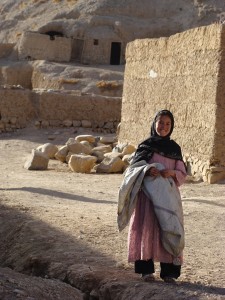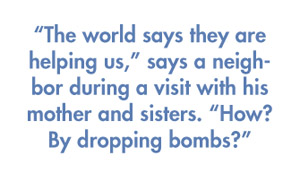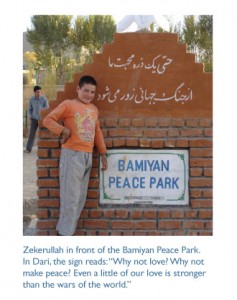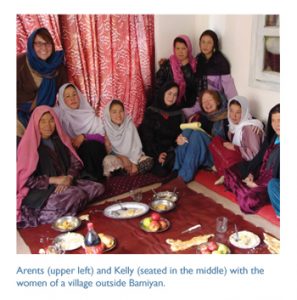Three American peace activists meet their young Afghani counterparts
by Kathy Kelly, Jerica Arents, and David Smith-Ferri | The Humanist
Published in the March/April 2011 Humanist
 Bamiyan Province in Afghanistan, a stunningly beautiful mountainous region, is located in the center of the country, roughly 100 miles northwest of Kabul. Most people here live in small, autonomous villages tucked into high mountain valleys, and work dawn to dusk just to scratch out a meager living as subsistence farmers, shepherds, or goatherds. The central government in Kabul and the regional government in Bamiyan City exercise little or no control over their lives. They govern themselves and live, for the most part, in isolation.
Bamiyan Province in Afghanistan, a stunningly beautiful mountainous region, is located in the center of the country, roughly 100 miles northwest of Kabul. Most people here live in small, autonomous villages tucked into high mountain valleys, and work dawn to dusk just to scratch out a meager living as subsistence farmers, shepherds, or goatherds. The central government in Kabul and the regional government in Bamiyan City exercise little or no control over their lives. They govern themselves and live, for the most part, in isolation.
Given this, who would imagine that Afghan youth from small villages across Bamiyan Province would come together to form a tight-knit, resilient, and effective group of peace activists? And, even more, that they would have a growing network of contacts and support that includes youth in other parts of the country and peace activists in the United States and in Palestine?
Calling themselves the Afghan Youth Peace Volunteers (AYPV), they range in age from eight to twenty-two, and have been active for over two years, translating their camaraderie and the horror of their families’ experience of war into a passionate and active pacifism. Like almost everyone living in Afghanistan, they have lost family members to violence, their families have been attacked and displaced, and they find the threat of future attacks real and frightening. And yet, taking courage and strength from each other, they aren’t letting violence define them.
Their activities include the transformation of a rock-strewn, abandoned lot into an attractive, landscaped Peace Park, an effort that took two and a half years and required them to overcome sizable bureaucratic hurdles, public derision, and even threats. Now they reach out to youth in other parts of Afghanistan to broaden their impact and diversify their makeup. They have participated in fasts organized by U.S. activists against torture, and they are currently seeking an opportunity to come to the United States to speak about their experiences and build bridges of friendship with people here.
The AYPV are guided by a remarkable young Singaporean doctor who gave up his private medical practice at home to live with people in Bamiyan. Hakim, a name given to him by local people that means “learned one,” is fluent in Dari, the local language, and he has lived here in an outlying village for over six years.
“With time,” he says, “I’m learning what it takes to practice what a young Afghan boy once told me—that without peace, life is impossible.”
Meeting the Peace Volunteers
At an invitation from AYPV, we three American peace activists from Voices for Creative Nonviolence arrive in Bamiyan for five days to learn more about these young activists and their families.
 Stiff and slightly sickened by the jarring forty-minute flight from Kabul, we disembark from a helicopter and step into the Bamiyan Valley, awash in bright autumn sunshine. Equally bright are the faces and smiles of the AYPV who are lined up and eagerly waiting for us. There is no question about whether we will carry our own luggage; the young Afghans whisk it away politely but firmly. Fifteen-year-old Abdulai, a small-boned but very sturdy Hazara boy from a potato-farming family, slings a very heavy suitcase over his back. “It’s OK,” he says with a mixture of pride and matter-of-factness. “I am a mountain boy.”
Stiff and slightly sickened by the jarring forty-minute flight from Kabul, we disembark from a helicopter and step into the Bamiyan Valley, awash in bright autumn sunshine. Equally bright are the faces and smiles of the AYPV who are lined up and eagerly waiting for us. There is no question about whether we will carry our own luggage; the young Afghans whisk it away politely but firmly. Fifteen-year-old Abdulai, a small-boned but very sturdy Hazara boy from a potato-farming family, slings a very heavy suitcase over his back. “It’s OK,” he says with a mixture of pride and matter-of-factness. “I am a mountain boy.”
In a country occupied by a foreign power, bleeding from military, political, and ethnic violence, worn by decades of war and corruption, the AYPV are looking for meaningful ways to raise a voice of nonviolence. Because there is so much suspicion and strife among the major ethnic groups in Afghanistan—Pashtun (44 percent of the total population), Hazara (18 percent), Tajik (25 percent), and Uzbek (7 percent)—the AYPV has sought ethnic diversity, both as a symbol of the need for reconciliation and to teach themselves tolerance. At present, there are only Hazara and Tajik youth in the group, largely because the population of Bamiyan Province is almost exclusively Hazara and Tajik.
Over dinner during our first evening together, we introduce ourselves and talk about the prejudice and intolerance that are such obstacles to peace in Afghanistan. Mohammad “Jan” (a term of endearment), a soft-spoken, strikingly handsome twenty-year-old Tajik, begins the discussion by saying, “War is increasing prejudice and divisions in Afghan society, because much of the fighting is happening along ethnic lines.” Some of the boys then discuss their own struggles with personal bias. “I was prejudiced against Pashtuns and Tajiks when I joined the group, but these prejudices are now gone,” Abdulai admits. Ali, a fourteen-year-old Hazara boy, concurs: “I was prejudiced against Tajiks. Now Mohammad Jan and Faiz (another Tajik member of the group) are like my brothers.”
Reflecting the well-documented subjugation of women in Afghanistan, there are presently no female AYPV members. The group is working to change this but the challenges are certainly there, especially in Bamiyan where women in outlying villages may only come into town once a year. The AYPV has reached out to a girls’ orphanage in Kabul and made some strong connections when they visited earlier in the year. However, one underlying principal for integrating the religiously and ethnically diverse group of girls at the orphanage into a cohesive “family” is to steadfastly ignore their differences. The girls most interested in participating in the AYPV happen to be Pashtun, and the orphanage staff knows that those who join would be seen as providing a “Pashtun” perspective. Our best sense of the situation is that the staff is not eager to encourage this.
Food Security
In a small storage shed at the edge of town, we watch as fourteen-year-old Sayed Qarim signs a simple contract agreeing to borrow and repay a no-interest loan of 25,000 aghanis (roughly $550). Daniel from the Zenda Company, the loan originator, counts out the crisp bills and hands them to Sayed, who smiles broadly. The two shake hands. Sayed, whose family farms potatoes and wheat, plans to use the funds to purchase a cow and her calf. “There are great benefits of owning a cow. Our family gets to use the milk, and we can sell the calf for a good profit,” he explains.
No one walking by on the narrow dirt road outside would know an important business transaction has just occurred—one that could in fact help a young man and his family gain economic traction and greater security. The transaction hasn’t taken place in a bank. No village leaders were present. Only a fourteen-year-old boy, the representative of a private business company, and a witness. And while the signed agreement constitutes a business relationship, the Zenda Company, a private business enterprise with a humanitarian focus, sees it as primarily personal.
Hakim, the Singaporean doctor who mentors the young AYPV members, is now working for Zenda. Getting to know prospective borrowers and monitoring and supporting people who have small business loans are among his primary responsibilities. In a country where villagers typically don’t farm enough land to actually subsist, where malnutrition and stunted growth are in fact the norm, and where the situation is worsening as land is divided and passed on to children, Hakim has learned that peace can’t be pursued separately from economic and food security.
Sayed was recommended for a loan by AYPV members Faiz and Mohammad Jan, who live in his village and who have themselves recently received and repaid loans. Following this recommendation, the Zenda company spent a good deal of time getting to know Sayed, assessing his knowledge, his resources (such as access to grazing land), and his character, answering his questions, and describing to Sayed his responsibilities as a borrower.
Now that the transaction is complete, Sayed is required to send a picture of the cow and her calf as proof that the money was used as agreed. In addition, Hakim will visit Sayed periodically. Along with Faiz and Mohammad Jan, he will try to provide whatever support Sayed needs to succeed, a crucial component of the program and its philosophy.
War Torn
Khamad Jan, age twenty-two, remembers that, as a youngster, he was a good student who enjoyed academics. “Now, I can’t seem to think,” he says sadly, looking at the ground. There is a long pause. “War does this to your mind.”
He and his family fled their village when Taliban forces began to attack. After his father was captured and killed, Khamad Jan bore responsibility as the eldest to provide for his mother, two brothers, and two sisters. But he struggled with debilitating depression, so much so that villagers, anxious to help, talked of exorcism. One day he felt ready to give up on life. Fortunately, community members and his friends in the Afghan Youth Peace Volunteers have helped him come to terms with the pain he feels, assuring him that he can find a meaningful future.
Assisted by an interest-free loan from Zenda, Khamad Jan has taken the risk of starting a small business producing potato crisps. Afghan potatoes are delicious, and Khamad Jan hopes that the quality of his crops will give him a slight competitive edge, even though a popular brand from the farm-subsidizing United States is flooding the market.
We meet Khamad Jan at a building site in a new settlement on the outskirts of Bamiyan city, where he coordinates construction of a small facility to house the potato chip production line. Earlier, we visited a shed that he rents to store his main pieces of equipment, a potato slicer and a bag sealer. When the new factory is complete, he’ll move the equipment in and start production. And if the business is profitable, maybe, just maybe, the family can break out of poverty. Khamad Jan notes that the assistance needed to do so must be direct, rather than through organizations that use resources for their own benefit. Earlier, his sisters were more assertive, telling us that much of the “help” they hear about on the radio goes to people who are corrupt and don’t share it.
Above all, they want to live without the constant fear of war. “The world says they are helping us,” says a neighbor of Khamad Jan’s during a visit with his mother and sisters. “How? By dropping bombs?”
“War destroys people,” Khamad Jan concludes, having just given us a tour of the developing potato crisp production factory. Again, he stares at the ground as he formulates what he wants to say. “It destroys our livelihood. It damages our minds.” After a long pause he adds, “All the players in this war have their own purposes for being here. There is absolutely no benefit to the people here from the wars that are being fought.”
You Are Not Alone
“All along I’ve been interested in peace,” Hakim says. “Morality, democracy, and intellectual honesty are dying. Here we have forty-three countries [in the International Security Assistance Force] trying to solve the problem of violence in Afghanistan. How can we allow these countries to say that more violence will solve the problems of violence, without asking them for evidence, for results?” He goes on, asking questions that would stay with us for the duration of the trip: “Where is intellectual inquiry? Moral skepticism? Why is war always the next solution? Why not reconciliatory talks—who dictates they are impossible for human beings? Why are we so willing to accept that violence and terror are the norm? If ordinary people don’t question this, academics at least should, but they don’t. A local shepherd boy knows this is not normal.”
 However not everyone in Bamiyan believes that leaving the cycles of force and violence behind is plausible. While meeting with college students, some only a few years older than the peace volunteers, some profess that peace is not a viable alternative. When asked about the AYPV’s work, one of the college students says, “[They] are fine, as far as they go, but this very small voice is of no consequence to the people of Afghanistan, and to ongoing international preparation for war.”
However not everyone in Bamiyan believes that leaving the cycles of force and violence behind is plausible. While meeting with college students, some only a few years older than the peace volunteers, some profess that peace is not a viable alternative. When asked about the AYPV’s work, one of the college students says, “[They] are fine, as far as they go, but this very small voice is of no consequence to the people of Afghanistan, and to ongoing international preparation for war.”
Still, in the face of opposition, the youths persist. “Even a little of our love is stronger than the wars of the world,” fifteen-year-old Abdulai remarks. “We should not let go of our hope, and we should ask with one voice: ‘Why not love?’”
To us, this teenager exhibits a remarkable understanding of the philosophy of nonviolence; it isn’t, as his elders understand, only a question of whether weapons should or should not be used to resolve conflicts. Abdulai understands nonviolence as a lifestyle, a commitment that permeates one’s daily behavior. It involves recognizing one’s self in the face of another, engaging in activities that cross the bridges of oppression, and approaching adversaries with transparency and respect.
On our last day in Bamiyan, at the small guest house where we’re staying, eight of us huddle around one cell phone to participate in a conference call organized by Fellowship of Reconciliation members in the United States. The call is part of an ongoing effort to foster a connection between the AYPV and volunteers at the Rachel Corrie Center in Gaza. The Gazan center was started by Cindy and Craig Corrie, whose daughter, Rachel, tried in 2003 to stop an Israeli bulldozer from destroying the home of a Gazan family that had befriended her. The bulldozer driver crushed her to death.
Anees, a Gazan who was with Rachel Corrie when she died eight years ago, answers the call. His home has been bombed four times in the past several years, and he has tried hard to cope with living in a land under siege. The AYPV is represented on this day by their youngest members—Zekerullah, fifteen, Ali, fourteen, and Gulemai, eleven. The others are busy harvesting potato crops, tending small shops, or going to classes.
These young boys understand the importance of making connections with people who share similar circumstances— that is, living in war zones.
Anees begins by describing his situation in Gaza, telling the boys that he and his family sometimes sleep with their boots on for fear that they might have to escape a bombardment in the middle of the night. “We wonder,” he adds, “if we lose our house, where will we go? Still, we must ask, what about the others? People in Gaza who were forced to move into schools and mosques after bombings are looking for apartments, but they have no funds to rebuild.”
“Anees,” says Ali, “if bombings start again near your house, please go someplace else!”
“Yes,” agrees Gulemai. “Come to Afghanistan!”
Anees explains that he has no permission to leave Gaza and that he often feels trapped. Abdulai asks for the phone. “I understand,” he says. “My family ran from the Taliban. My father was captured and killed.”
Zekerullah then recalls a terrible time in his young life when people being attacked in his village tried to hide in drainage ditches or in potato storage bins. Gulemai tells Anees that he has an uncle who disappeared and was never found. The uncle went missing ten years ago, after a bombing. “Did my uncle live, or was he put in prison?” Gulemai asks. “To this day my family and I feel the pain.”
Zekerullah talks about the day his own uncle was shot—his body riddled with bullets. “It was a terrible situation, like what you have just described.” Ali nods his head, indicating he wants to take the phone. “Please remain strong and brave,” he tells Anees. “We will endure this together, with you. If it’s beyond enduring, please call us. Life will pass, but if it’s beyond enduring,” he repeats, “you must call us.”
“Yes,” echoes Gulemai. “We share your pain. You are not alone. Please don’t give up.”
It’s agonizing to slow down, stop, and experience the shared pain of war. The Afghan Youth Peace Volunteers have spoken several times with Rachel Corrie’s parents. They believe it’s crucial to express what in their Dari language is called hamdard, meaning “shared pain.”
What about the Women?
When meeting with mixed groups of Afghanis, the men tend to dominate the conversation. However, after meeting with the men in the family in conservative Afghan villages, the women of our trio move into a separate room to visit with the women. They’ve gathered there and are waiting eagerly with their children. After greetings, smiles, and expressions of thanks, the conversation begins with comments about the style of our clothes, the quality of Jerica’s young hands, or the strangeness of her backpack.
In the absence of their male counterparts, the Afghan women, adorned in vibrant cloths, fill the sparsely furnished rooms with stories and laughter. One woman shares the heartbreaking experience of having her husband kidnapped and killed by the Taliban—and of raising her children, now teenagers, without the breadwinner of the house. She looks down at her wrinkled hands and pauses before telling us of her struggles with depression. “We age so quickly here,” she reflects, looking up at us, circles under her eyes. Her skin is weathered and worn, bearing the years of harsh living conditions and inadequate nutrition. We guess she’s in her late fifties—we later learn that she is only thirty-eight years old.
 These women are burdened with the physical manifestations of war and its recollection, of malnutrition, and of hard labor in harsh elements. They have developed strong coping mechanisms to handle the severe headaches, depression, and anemia that plague their daily lives. As noted, they typically only leave their village once a year and then only to go to the market in Bamiyan city, a trip they make clad in full burqas. For generations, these women have been defined and identified by the existence of their children, spending their time tending to the needs of their large families in a pastoral culture. “We are all illiterate,” says the thirty-eight-year-old mother, “so we harvest potatoes.” What they need, she says, is “good, dignified work so we can take care of our families.”
These women are burdened with the physical manifestations of war and its recollection, of malnutrition, and of hard labor in harsh elements. They have developed strong coping mechanisms to handle the severe headaches, depression, and anemia that plague their daily lives. As noted, they typically only leave their village once a year and then only to go to the market in Bamiyan city, a trip they make clad in full burqas. For generations, these women have been defined and identified by the existence of their children, spending their time tending to the needs of their large families in a pastoral culture. “We are all illiterate,” says the thirty-eight-year-old mother, “so we harvest potatoes.” What they need, she says, is “good, dignified work so we can take care of our families.”
What Friends Are For
If we want to understand war and its effects, surely we should be talking to the people who disproportionately bear its costs: people like Khamad Jan and his family and the Afghan women we were privileged to meet. In our experience in Afghanistan, however, these people are also the most excluded from the conversation and the least likely to benefit from social change. Asked what we could tell Americans when we returned home, Mohammad Jan’s older brother Tooryalai said, “Tell them to come to Afghanistan and make friends.” In this spirit, if we can hold these most vulnerable people in our minds every day, it can help us inhabit this planet more sustainably, more lovingly. In a world that desperately needs the combined creative energies of people who are currently separated by ignorance and war, we, too, can become peace volunteers, walking a path of nonviolence and compassion.
Kathy Kelly, Jerica Arents, and David Smith-Ferri are co-coordinators of Voices for Creative Nonviolence (www.vcnv.org).
